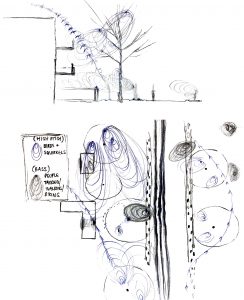In-Class Exercise

In this exercise I observed sounds from my balcony. My method of representation uses black to show sounds with bass (People talking, walking, and biking) and blue to show sounds with higher pitches (chirping birds and the rattling and rustling of squirrels). The location, paths, and radiation of these sounds are shown both in plan and section.
Assignment 8-
Tuning In

I sat at a bench at Kitsilano Beach Park and observed the sounds around me. I thought about each sound and tried to express its characteristics through lines and how I experienced them traveling into my ear. The loudest sounds were the crashing waves of the water which is expressed in back and forth movement, getting noisier when crashing into a wall or the sand at the shore. The airplane above was loud, but not as crisp of a sound compared to the water. The airplane sound lines are shown as very blurry and dense. Similar distant sounds were the trees and vehicle traffic happening behind me, which are shown as a background noise which was not as overwhelming and distinguishable. The sounds of people walking, talking, running, and biking on the path were significantly dynamic and quickly paced. For example, the sound of a bike zipping by was louder as it approached and became quit immediately when it left. Its closeness allowed me to hear the sound of the tire rubber rolling on damp asphalt. The path of the tires and their rolling shape show their presence in my hearing experience, as the bottoms of the tires are darkened to show their unique sounds when making contact with the wet ground. The sounds of dogs running on the beach were faint, as the small movement of sand from their paws are represented with faint sand-like dots.
Wind Play
I created a wind-play object from plastic. Cutting equally sized strips and tying them together, I formed three long strips. After observing how they behaved in the wind, I was surprised to how the weight of the knots changed the way each strip swayed in the wind. The contrast between the three strips created a dancing effect, as each strip uniquely wiggled but still followed the same motion and direction of the other. The structured fluidity of the object’s movements reminded me of an octopus and its tentacles moving underwater. I learned from creating this object that wind energy plays an important role in not only natural occurring forms and patterns, but how vegetation and habitat behave and move. How can we design so wind can be “seen” or manipulated in the landscape?